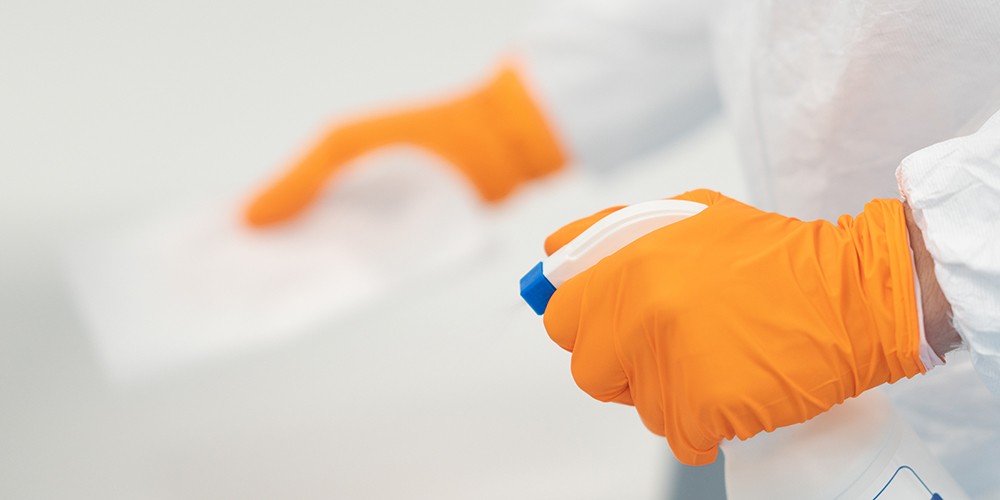It can be challenging to keep a cleanroom clean and maintain its ISO class. Everything you introduce will likely release particles into the air — especially people! So, what are the best ways to keep your cleanroom up to the standards you so painstakingly maintained? Here are some basic concepts and helpful suggestions to maintaining the highest level of cleanliness.
Gowning: First and foremost, anyone entering the cleanroom must wear protective clothing. Humans are full of particles: our hair falls out, our skin flakes, and there’s no way to control it. That’s why anyone entering the cleanroom must wear appropriate protective clothing. Depending on your cleanroom’s class, this might be a gown and gloves or a full head-to-toe cleanroom coverall complete with a mask and goggles. You first have to define your standards, but then you should know what your employees should wear in the cleanroom.
Cleaning: Why do you need to clean a cleanroom if it’s already clean? Because of the inevitable introduction, generation, and retention of particles! If you are concerned with bioburden, you don’e just need to clean. You need to clean and disinfect! This is a two-stage process. First, you clean away the dirt (or, as we call it in the cleanroom industry, non-viable contamination), then disinfect the germs (viable contamination).
Cleanroom Furniture: Believe it or not, furniture can give off particles even when it’s just sitting there. And even when furniture doesn’t generate particles, it can accumulate them. That’s why cleanroom furniture has smooth edges and joins. Without dirt traps, particles and dust won’t build up on furniture. You’ll need to invest in this type of furniture to keep your cleanroom clean.
Air Shower: To limit the number of particles brought into your cleanroom, you might consider investing in an air shower. Used in conjunction with the gowning room, it blows off any particles that could easily fall off people entering the cleanroom. It’s a great way to eliminate extra particles before operatives enter the room. The experience can also get operatives into the right mindset of controlling contamination.
Sticky Mats: This is the best way to reduce foot-borne or wheel-borne contaminates. If your cleanroom has a high standard for cleanliness, this is a useful addition to your cleanroom.
Proper Cleanroom Gowning Techniques
The cleanroom gowning process may seem like a hassle, but you spend a lot of money getting the cleanroom installed and maintained, so a few extra minutes gowning properly isn’t a big deal if you’re protecting that asset and keeping your cleanroom as clean as possible. But what, exactly, do you have to do to make sure you and your employees are following proper protocol and protecting the environment of the cleanroom? It starts with a standard procedure. It will be much simpler if everyone follows the exact same process and understands the different areas of the gowning space. Generally, most gowning spaces have a “getting dressed” area and a “cleaner” area. Make sure employees understand these boundaries, and know where to stand at what point in the gowning process. Here’s an example of a standard gowning process. Remember, however, that most gowning processes will vary depending on the standard you’re required to adhere to.
- Perfume and Cosmetics – If you’re working in a cleanroom, the gowning process starts before you even get to work. It’s important to remember that products like perfume, make-up, hair gels, etc. give off extra fumes and particles. To keep your cleanroom as clean as possible, it’s necessary that anyone entering the room not wear these types of products.
- Remove personal items – Personal items like jewelry also have to come off before you go into your cleanroom. They, just like cosmetics, release extra, unnecessary particles into the air that you’re better off without.
- Change Shoes – Shoes pick up all kinds of dirt and dust when you walk around. It’s a good idea to change your shoes once you walk into the building, and then as you enter the gowning area, make sure you step on a sticky mat to remove any excess particles.
- Enter Gowning Area – Now you’ll enter the gowning room, and most places have a “getting dressed” area, which is where you’ll start. Make sure to put on a set of “donning gloves” or just a first set of gloves to eliminate particle contamination of gowning clothes. When gowning, remember to dress from head to toe; this eliminates particles from falling onto already gowned parts like coveralls and booties.
- Don Bouffant – First, you’ll put on your bouffant, or hair cover. Make sure to only touch the inside of it, and before you move on, ensure that all hair is covered and out of the way. After this, you may also have to don a hood, depending on your cleanroom’s standards.
- Don Coverall – If your coverall is one piece, start with the feet and move upwards. If it’s two pieces, start with the top and then sit down to put on the bottom half. Do not let the coverall touch the floor or walls. Make sure you zip all zips, and snap all snaps.
- Booties or Shoe Covers – Now, sit on the bench to don booties or shoe covers. Make sure you tuck your pants into the booties or shoe covers, and don’t step in the “getting dressed’ area. Instead, step into the “cleaner” area of the gowning room. If your cleanroom has an automatic shoe cover dispenser, use that for cleanliest practice.
- Don Goggles or Shield – If your cleanroom requires them, this is where you put on your goggles or face shield. Some cleanrooms do not require this level of protection, so you may be able to skip this step.
- Final Pair of Gloves – Depending on protocol, you may now remove the first pair of gloves and put on a second, or you may put a second pair of gloves over the first. Roll the cuff of the gloves over top of your sleeves.
- Enter – Now that you’ve properly gowned, you may enter the cleanroom. Remember that at this point you are as “clean” as you’re going to get, so if you touch anything before you get inside, you’ll have to start over, or at the very least change your gloves.
If you have anymore questions regarding the information provided above, please reach out to one of our experts. The experienced experts at Angstrom Technology can answer any of your questions quickly and efficiently, and would love to hear from you!
GET INSTANT ACCESS TO OUR CLEANROOM DESIGN GUIDE



